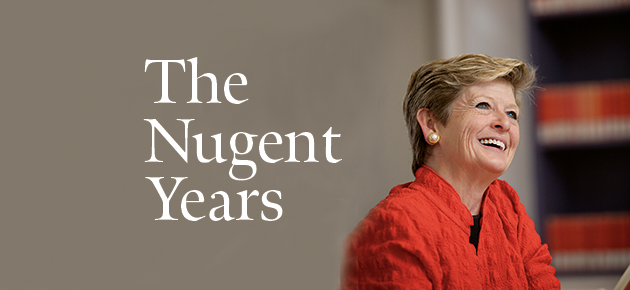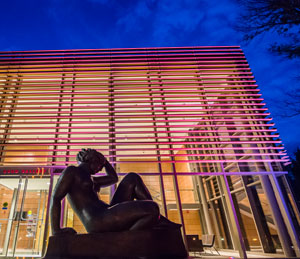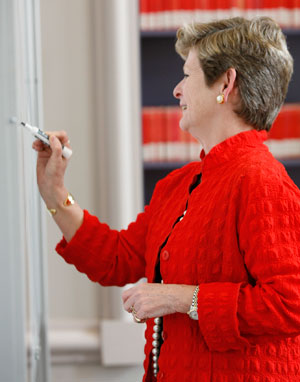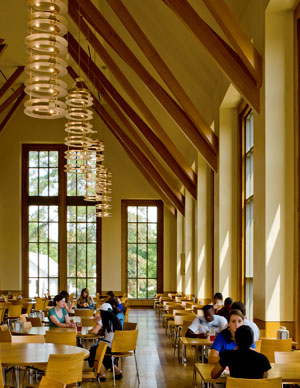Volume 35 Number 2 Winter 2013
In this Issue
Features
- The Nugent Years
- Inspector Gadget
- Hip Hop Sure Shot
- Everlasting Speech
The Editor's Page
- Letters to the Editor
- The Not-So-Super Market
Along Middle Path
- Gambier is Talking About...
- Test your KQ
- Late Night Nosh
- Anatomy of an Athlete
- Kenyon Now
- Pass/Fail
- Margin of Error
- Kenyon in Quotes
- The Hot Sheet
Books
- Woody at 100: The Woody Guthrie Centennial Collection
- Recent Books by Kenyon Authors
Office Hours
- Internalize This
- Trees of Life
Alumni News
- Class Notes
- Sight Unseen
- See How She Runs
- Obituaries
- Alumni Digest
The Last Page
- As technology advances...how could it affect the evolution of species? Let's take a look ahead...

Related Information
Quotes from President Nugent and others
President Nugent and the Kenyon community reflect on her decade of accomplishments and leadership. More...
When S. Georgia Nugent announced last August that she would be stepping down as Kenyon's president at the end of the 2012-13 academic year, notes of thanks and appreciation came in from all quarters.
"You've enhanced this college . . . as no other president has done in my time here," wrote Professor of Sociology Howard Sacks, a faculty member for thirty-seven years. "You have empowered the women on the staff in a way . . . that would not have fully happened with a different leader," wrote Mary Kay Karzas '75, a current trustee who as Alumni Council president served on the 2002-03 search committee that helped to choose Nugent. Professor of Anthropology David Suggs wrote Nugent, "I can only hope that we will find someone to replace you who will be almost as forthright and genuine as you have been."
Kenyon's eighteenth--and first female--president has led the College through a decade of remarkable accomplishment and change. Nugent's Kenyon's eighteenth president departs after a decade of accomplishment and leadership Kenyon is the Kenyon of the Gund Gallery and Horvitz Hall, the Center for the Study of American Democracy as well as the Gambier Child Care Center, the Kenyon of energy-saving geothermal wells and local food. It's a Kenyon of notable strides in admissions selectivity, faculty recruiting, resources for financial aid, and national recognition.
Her tenure hasn't been free of conflict. No college presidency is. Kenyon leaders in the past have wrestled with divisive issues ranging from fraternity housing to curricular change. During Nugent's final year, proposals to outsource maintenance operations have generated heated debate.
Other observers, with a longer perspective, can gauge the importance of various controversies. Here, before the College says farewell to Georgia Nugent, it's more fitting to review some of the major successes that Kenyon achieved under her leadership. These pages give a brief picture of the Nugent Decade, with reflections by her and others. -The Editors
The Kenyon Campus
President Nugent leaves a tangible legacy in the form of new and renovated buildings that have transformed
the campus while preserving its integrity. Her first official act at the College-in April 2003, months before she actually assumed office-was to heft a shovel at the groundbreaking ceremony for the Kenyon Athletic Center. That facility had been planned earlier, but under Nugent the College added an array of equally magnificent buildings, most notably the Graham Gund Gallery, Horvitz Hall (for studio art), and the completely renovated Peirce-Dempsey dining complex. Other projects included Lentz House for the English Department, O'Connor House for interdisciplinary programs, Finn House and the Cheever Room for the Kenyon Review, and a new neighborhood of townhouse residences in the north campus.
The Faculty
Nugent's administration has set a high priority on faculty recruitment, raising salaries to remain competitive while also addressing quality-of-life concerns such as family leave and child care. Faculty diversity has increased under Nugent: 24 percent of faculty members are now persons of color or international. The College also increased funding for faculty research, while cultivating teaching excellence through "Teachers Teaching Teachers"-in which professors share expertise to broaden interdisciplinary knowledge-and through the Center for Innovative Pedagogy, which explores interactive learning techniques and instructional technologies. The "We Are Kenyon" campaign created endowed professorships in anthropology, drama, economics, English, and international studies.
Leading Like a Teacher
Senior Staff colleagues who have worked closely with Nugent describe her as a leader with a collaborative style who acts decisively but calmly in a crisis.
"She taught me a lot about how to lead by helping others to succeed," said Vice President for College Relations Sarah Kahrl. "She empowers the people around her to do their best work for the College. Some presidents insist on primacy. Georgia's leadership style is that of a good teacher; she leads by seminar. She frequently talked about Senior Staff as a team; we worked together in a very collegial way."
Nugent was "direct, honest, and transparent," said Howard Sacks, the sociology professor who served with her as both interim provost and senior advisor. "You really heard what she honestly thought. There were no hidden agendas."
Sacks valued Nugent's "sense of perspective, which allowed her to stay very even-tempered, even in moments of crisis and frustration." He recalled the "Stand Up for Kenyon" demonstration of solidarity on Middle Path that Nugent and others organized in the fall of 2007, in response to vandalism involving swastikas and other slurs.
Kahrl praised Nugent for "superb leadership" after the alcohol-related death of freshman Colin Boyarski in April 2005. Rather than turning to heavy-handed punitive measures, Nugent backed a Good Samaritan policy encouraging students to call the Safety Office for help without fear of being cited for alcohol or drug violations.
She also joined other college presidents in the "Amethyst Initiative," advocating a re-examination of the twenty-one-year-old drinking age.
The Academic Program
A classicist and gifted teacher, Nugent came to the College with an appreciation for its core academic values, and in launching "We Are Kenyon" she spoke about the importance of "keeping Kenyon Kenyon." During
her tenure, the College enriched rather than altered the curriculum-for example, recognizing the importance
of global perspectives by creating programs in Islamic culture and Latino studies. The campaign, which ran from 2006 to 2011, gave Kenyon two institutions that have added new dimensions to intellectual life. One
is the Center for the Study of American Democracy, which has filled the calendar with lectures, debates, and
symposia on public issues, often involving distinguished scholars and political figures. The other is the Graham Gund Gallery, which has emerged as a cultural hub hosting exhibitions, performances, and lectures in diverse academic realms.
Professor Nugent
Always an avid teacher and scholar, Nugent found time to team-teach several courses in classics. "She jumped in with both feet and was a great asset," said Professor of Classics Carolin Hahnemann, who teamed with Nugent for "Greek and Roman Drama" in the spring of 2011. "She's lucid and well organized, as you might expect. And she laughs quite a bit. She can take the capital C out of classics. It's very inviting."
Any initial self-consciousness about having the Kenyon president in class evaporated quickly, said Hahnemann. "I felt I could really be myself, and students felt free to question and disagree with her."
When Associate Professor of Classics Adam Serfass team-taught "Advanced Latin: The Age of Nero" with Nugent in the spring of 2007, he valued her directness with students in critiquing translations and her command of theory. "She taught me how to break down an abstruse article in a way that was useful to students. This was
very helpful."
In examining secondary works, the class also benefited from Nugent's stature in the field. "She's immensely
connected," said Serfass. "We would be discussing an author, and she would know him and be able to explain his approach and the genesis of his work."
Like Hahnemann, Serfass was struck by Nugent's sense of humor. "We were reading rollicking, entertaining prose works with passages on food, sex, and politics. We had some interesting discussions of scatological and sexual vocabulary, which she handled with aplomb. It was amazing."
First Female
Did Nugent encounter resistance as the first female president of a college with a long all-male history? She feels that Kenyon was ready for the change, noting that women across the Kenyon family welcomed her with particular enthusiasm. She does point out, however, that a few eyebrows went up when she named two women to serve in key posts-Sarah Kahrl as head of fundraising and Jennifer Delahunty as admissions dean.
"I actually hired equal numbers of male and female Senior Staff members," she said, "but a few people told me that I was hiring all women. I've spoken with a number of female presidents around the country, and all of us have experienced that-when you hire in equal numbers, some see it as tilted female."
She laughed. "It remains a bit of a challenge, I think, to be a woman leader."
Expanding Access
As a first-generation college student herself, Nugent took a personal interest in the goal of increasing financial aid to make a Kenyon education affordable for talented students regardless of their socioeconomic background. The campaign brought in $60 million in new endowment for financial aid, doubling endowment funds for that purpose. The lead gift of $10 million came from Paul Newman and the Newman's Own Foundation, establishing a scholarship program that allows the neediest students to graduate loan-free. Under Nugent, the College also introduced KEEP and REACH, academic enrichment and mentoring programs designed to help minority and first-generation students succeed at Kenyon.
Sustainability
A constellation of concerns-for the environment, energy conservation, and the College's role in the community-came together as Kenyon more ambitiously embraced principles of sustainability. Both the Gund Gallery and the north campus townhouses incorporate features, including energy-efficient geothermal wells for heating and cooling, that qualified them for certification under the Leadership in Energy and Environmental Design program of the U.S. Green Building Council. (The gallery earned silver certification; the first phase of the townhouse project is expected to earn gold.) The College also established a Sustainability Office that has begun implementing water and energy-conservation programs campuswide.
The Kenyon Workplace
The Gambier Child Care Center, which opened in 2007, was just one initiative through which Nugent improved the quality of life for Kenyon employees. The College also developed a family leave policy to help new parents as well as employees dealing with serious health problems affecting family members. On arriving at Kenyon in 2003, Nugent also addressed staff complaints about unfairness, by arranging for an outside review of the compensation system and then implementing changes. She also enhanced the ombudsperson position and established the Presidential Advisory and Communications Team (PACT ) as a forum for the discussion of workplace issues.

Reaching Out
Nugent's belief in community engagement evidenced itself in strong support for the College's Food for Thought program and the Rural Life Center. She made sure that Kenyon participated in local charitable efforts like Food for the Hungry, and made College facilities available for important community events. "We need to demonstrate the good citizenship, as an institution," she said, "that we seek to develop in our students as part of a liberal arts education."
Student Life
The Peirce Hall renovation and the new north campus townhouses stand as major contributions of the Nugent presidency to the quality of campus life. The Peirce project restored signature spaces like the Great Hall while expanding and modernizing the servery, adding new dining areas such as Thomas Hall in a totally rebuilt Dempsey, providing equipment and logistics to support Kenyon's local-foods program, and creating new spaces for student organizations. The townhouses brought long-needed improvements to residential life.
Gambier, Ohio 43022
(740) 427-5158

 Delicious
Delicious Facebook
Facebook StumbleUpon
StumbleUpon Digg
Digg reddit
reddit